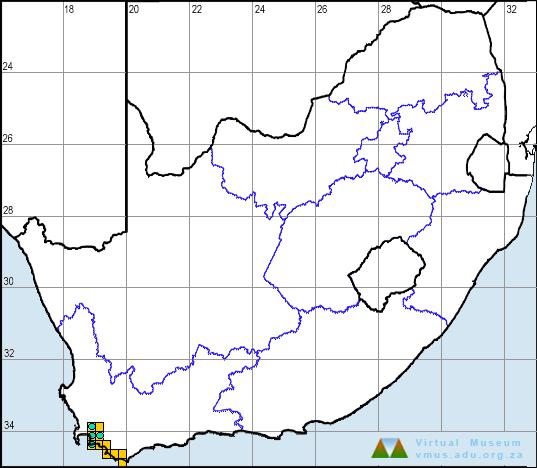View the above photo record (by Megan Loftie-Eaton) in FrogMAP here.
Find De Villiers’ Moss Frog in the FBIS database (Freshwater Biodiversity Information System) here.
Family Pyxicephalidae
DE VILLIER’S MOSS FROG – Arthroleptella villiersi
Hewitt, 1935
Habitat
A. villiersi is found in montane fynbos where the annual rainfall is >750 mm. It inhabits seepages and has been found amongst thick vegetation alongside small streams, even in plantations of exotic trees (A. Turner and A.L. de Villiers pers. comm.).
Behaviour
This species breeds in dense vegetation on wet slopes. Males call from concealed positions under moss or other vegetation, in damp areas (Channing 2001). Calling has been recorded during most months of the year except the driest summer months, while eggs have been found between July and November. A clutch comprises about 11 eggs, laid in a jelly mass 30 mm in diameter, often at the base of a wet, moss covered rock. Other nests have been found lightly concealed beneath overhanging grass on wet slopes and at the sides of road cuttings (Channing 2001). Metamorphosis takes place after 10–14 days.
Status and Conservation
A. villiersi is relatively widespread and often numerous. A large proportion of its habitat falls within protected areas, both statutory and private. The species does not need special conservation action.
Distribution
A. villiersi is endemic to the Western Cape Province where it is found on the slopes of the Hottentots Holland, Kogelberg, and Kleinrivier mountains and eastward to the Bredasdorp Mountains. It occurs from sea level at Rooi Els and Betty’s Bay, to altitudes of 1800 m. This species is sympatric with A. drewesii and A. landdrosia in places, but can be distinguished by differences in its advertisement call (see relevant species accounts) (Channing et al. 1994b). The atlas data are reliable.

Further Resources
Virtual Museum (FrogMAP > Search VM > By Scientific or Common Name)
More common names: De Villiers’ Chirping Frog (Alternative English Name); De Villiers se Mospaddatjie (Afrikaans).
Recommended citation format for this species text:
Channing A, Tippett RM. De Villiers’ Moss Frog Arthroleptella villiersi. BDI, Cape Town.
Available online at http://thebdi.org/2022/02/14/de-villiers-moss-frog-arthroleptella-villiersi/
Recommended citation format:
This species text has been updated and expanded from the text in the
2004 frog atlas. The reference to the text and the book are as follows:
Channing A 2004 Arthroleptella villiersi De Villiers’ Moss Frog. In Minter LR
et al 2004.
Minter LR, Burger M, Harrison JA, Braack HH, Bishop PJ, Kloepfer D (eds)
2004. Atlas and Red Data Book of the Frogs of South Africa, Lesotho and
Swaziland. Smithsonian Institution, Washington, and Avian Demography
Unit, Cape Town.

